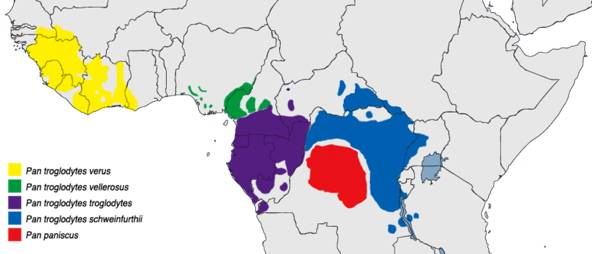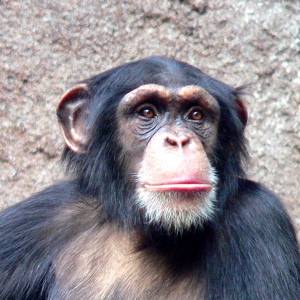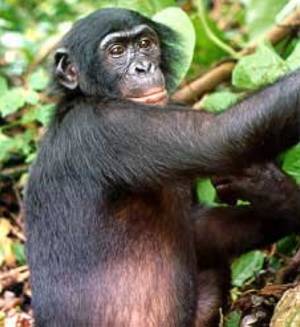Chimpanzee habitat
 Distribution of chimpanzee habitat in Africa
Distribution of chimpanzee habitat in Africa
 Common Chimpanzee
Common Chimpanzee(Pan troglodytes)
 Bonobo
Bonobo(Pan paniscus)
Typical chimpanzee habitat is tropical rainforest (see video below), but chimpanzees are also found in forest-savanna mosaic and in montane rainforest up to about 3,000 meters. Tropical rainforests are lowland equatorial evergreen forests that receive high levels of rainfall throughout the year (typically more than 2000 mm, or 80 inches, annually). Montane rainforests, also known as cloud forests, are found in cooler-climate mountainous areas in the tropics.
The foregoing comments refer to the common chimpanzee (Pan troglodytes). The very similar pygmy chimpanzee, or bonobo (Pan paniscus), has a more restricted habitat. It occurs exclusively in lowland rainforest south of the Congo River, which separates it range from that of the common chimpanzee (see map above). The river is an effective barrier, not only because it is wide and crocodile infested, but also because chimpanzees are afraid of water and cannot swim. If they happen to fall into deep water, they sink like stones. The IUCN describes bonobo habitat as follows:
Chimpanzees (both P. troglodytes and P. paniscus), which occur naturally only in tropical Africa, spend most of their time in trees and often move from one tree to another without descending to earth. Much of their food comes from arboreal foraging. They also sleep in trees, building a new nest almost every evening. During the rainy season, nests are often used for resting during the day. However, they do spend a good bit of time on the ground, especially when traveling longer distances, or when searching for foods that can't be found in trees.
Both types of chimpanzee occur over a broad geographic range, especially the common chimpanzee, but their ranges are now fragmented due to human population increase and associated agricultural and logging activity (see map above). Populations have remained relatively stable in protected areas, but have been declining drastically outside of parks as the forests were cleared. The IUCN rates both the common chimpanzee and the bonobo as as endangered.
Video: Cannibal chimpanzees in their habitat: